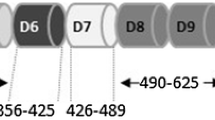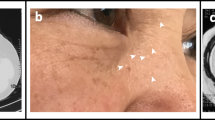Abstract
Background
Many COL4A5 splice region variants have been described in patients with X-linked Alport syndrome, but few have been confirmed by functional analysis to actually cause defective splicing. We sought to demonstrate that a novel COL4A5 splice region variant in a family with Alport syndrome is pathogenic using functional studies. We also describe an alternative method of diagnosis.
Methods
Targeted next-generation sequencing results of an individual with Alport syndrome were analyzed and the results confirmed by Sanger sequencing in family members. A splicing reporter minigene assay was used to examine the variant’s effect on splicing in transfected cells. Plucked hair follicles from patients and controls were examined for collagen IV proteins using immunofluorescence microscopy.
Results
A novel splice region mutation in COL4A5, c.1780-6T>G, was identified and segregated with disease in this family. This variant caused frequent skipping of exon 25, resulting in a frameshift and truncation of collagen α5(IV) protein. We also developed and validated a new approach to characterize the expression of collagen α5(IV) protein in the basement membranes of plucked hair follicles. Using this approach we demonstrated reduced collagen α5(IV) protein in affected male and female individuals in this family, supporting frequent failure of normal splicing.
Conclusions
Differing normal to abnormal transcript ratios in affected individuals carrying splice region variants may contribute to variable disease severity observed in Alport families. Examination of plucked hair follicles in suspected X-linked Alport syndrome patients may offer a less invasive alternative method of diagnosis and serve as a pathogenicity test for COL4A5 variants of uncertain significance.



Similar content being viewed by others
References
Kashtan CE (1999) Alport syndrome. An inherited disorder of renal, ocular, and cochlear basement membranes. Medicine (Baltimore) 78:338–360
Tryggvason K, Zhou J, Hostikka SL, Shows TB (1993) Molecular genetics of Alport syndrome. Kidney Int 43:38–44
Renieri A, Meroni M, Sessa A, Battini G, Serbelloni P, Torri Tarelli L, Seri M, Galli L, De Marchi M (1994) Variability of clinical phenotype in a large Alport family with Gly 1143 Ser change of collagen alpha 5(IV)-chain. Nephron 67:444–449
Tsiakkis D, Pieri M, Koupepidou P, Demosthenous P, Panayidou K, Deltas C (2012) Genotype-phenotype correlation in X-linked Alport syndrome patients carrying missense mutations in the collagenous domain of COL4A5. Clin Genet 82:297–299
Pierides A, Voskarides K, Kkolou M, Hadjigavriel M, Deltas C (2013) X-linked, COL4A5 hypomorphic Alport mutations such as G624D and P628L may only exhibit thin basement membrane nephropathy with microhematuria and late onset kidney failure. Hippokratia 17:207–213
Demosthenous P, Voskarides K, Stylianou K, Hadjigavriel M, Arsali M, Patsias C, Georgaki E, Zirogiannis P, Stavrou C, Daphnis E, Pierides A, Deltas C (2012) X-linked Alport syndrome in Hellenic families: phenotypic heterogeneity and mutations near interruptions of the collagen domain in COL4A5. Clin Genet 81:240–248
Jais JP, Knebelmann B, Giatras I, De Marchi M, Rizzoni G, Renieri A, Weber M, Gross O, Netzer KO, Flinter F, Pirson Y, Verellen C, Wieslander J, Persson U, Tryggvason K, Martin P, Hertz JM, Schroder C, Sanak M, Krejcova S, Carvalho MF, Saus J, Antignac C, Smeets H, Gubler MC (2000) X-linked Alport syndrome: natural history in 195 families and genotype–phenotype correlations in males. J Am Soc Nephrol 11:649–657
Jais JP, Knebelmann B, Giatras I, De Marchi M, Rizzoni G, Renieri A, Weber M, Gross O, Netzer KO, Flinter F, Pirson Y, Dahan K, Wieslander J, Persson U, Tryggvason K, Martin P, Hertz JM, Schroder C, Sanak M, Carvalho MF, Saus J, Antignac C, Smeets H, Gubler MC (2003) X-linked Alport syndrome: natural history and genotype-phenotype correlations in girls and women belonging to 195 families: a “European Community Alport Syndrome Concerted Action” study. J Am Soc Nephrol 14:2603–2610
Hertz JM, Thomassen M, Storey H, Flinter F (2012) Clinical utility gene card for: alport syndrome. Eur J Hum Genet 20(6). doi: 10.1038/ejhg.2011.237
Larsen CP, Durfee T, Wilson JD, Beggs ML (2016) A custom targeted next-generation sequencing gene panel for the diagnosis of genetic nephropathies. Am J Kidney Dis 67:992–993
Nilsson SC, Karpman D, Vaziri-Sani F, Kristoffersson AC, Salomon R, Provot F, Fremeaux-Bacchi V, Trouw LA, Blom AM (2007) A mutation in factor I that is associated with atypical hemolytic uremic syndrome does not affect the function of factor I in complement regulation. Mol Immunol 44:1835–1844
Desmet FO, Hamroun D, Lalande M, Collod-Beroud G, Claustres M, Beroud C (2009) Human splicing finder: an online bioinformatics tool to predict splicing signals. Nucleic Acids Res 37:e67
Yeo G, Burge CB (2004) Maximum entropy modeling of short sequence motifs with applications to RNA splicing signals. J Comput Biol 11:377–394
Brunak S, Engelbrecht J, Knudsen S (1991) Prediction of human mRNA donor and acceptor sites from the DNA sequence. J Mol Biol 220:49–65
Schwartz S, Hall E, Ast G (2009) SROOGLE: webserver for integrative, user-friendly visualization of splicing signals. Nucleic Acids Res 37:W189–W192
Vreeswijk MP, van der Klift HM (2012) Analysis and interpretation of RNA splicing alterations in genes involved in genetic disorders. Methods Mol Biol 867:49–63
Bonnet C, Krieger S, Vezain M, Rousselin A, Tournier I, Martins A, Berthet P, Chevrier A, Dugast C, Layet V, Rossi A, Lidereau R, Frébourg T, Hardouin A, Tosi M (2008) Screening BRCA1 and BRCA2 unclassified variants for splicing mutations using reverse transcription PCR on patient RNA and an ex vivo assay based on a splicing reporter minigene. J Med Genet 45:438–446
Gaildrat P, Killian A, Martins A, Tournier I, Frébourg T, Tosi M (2010) Use of splicing reporter minigene assay to evaluate the effect on splicing of unclassified genetic variants. Methods Mol Biol 653:249–257
Kagawa M, Kishiro Y, Naito I, Nemoto T, Nakanishi H, Ninomiya Y, Sado Y (1997) Epitope-defined monoclonal antibodies against type-IV collagen for diagnosis of Alport’s syndrome. Nephrol Dial Transplant 12:1238–1241
Borza DB, Bondar O, Ninomiya Y, Sado Y, Naito I, Todd P, Hudson BG (2001) The NC1 domain of collagen IV encodes a novel network composed of the alpha 1, alpha 2, alpha 5, and alpha 6 chains in smooth muscle basement membranes. J Biol Chem 276:28532–28540
Nozu K, Vorechovsky I, Kaito H, Fu XJ, Nakanishi K, Hashimura Y, Hashimoto F, Kamei K, Ito S, Kaku Y, Imasawa T, Ushijima K, Shimizu J, Makita Y, Konomoto T, Yoshikawa N, Iijima K (2014) X-linked Alport syndrome caused by splicing mutations in COL4A5. Clin J Am Soc Nephrol 9:1958–1964
King K, Flinter FA, Green PM (2001) Hair roots as the ideal source of mRNA for genetic testing. J Med Genet 38:E20
Tazon-Vega B, Ars E, Burset M, Santin S, Ruiz P, Fernandez-Llama P, Ballarin J, Torra R (2007) Genetic testing for X-linked Alport syndrome by direct sequencing of COL4A5 cDNA from hair root RNA samples. Am J Kidney Dis 50:257.e1–257.e14
Savige J, Colville D, Rheault M, Gear S, Lennon R, Lagas S, Finlay M, Flinter F (2016) Alport syndrome in women and girls. Clin J Am Soc Nephrol 11:1713–1720
Gross O, Netzer KO, Lambrecht R, Seibold S, Weber M (2002) Meta-analysis of genotype-phenotype correlation in X-linked Alport syndrome: impact on clinical counselling. Nephrol Dial Transplant 17:1218–1227
Hasegawa H, Naito I, Nakano K, Momota R, Nishida K, Taguchi T, Sado Y, Ninomiya Y, Ohtsuka A (2007) The distributions of type IV collagen alpha chains in basement membranes of human epidermis and skin appendages. Arch Histol Cytol 70:255–265
Kuroki A, Ito J, Yokochi A, Kato N, Sugisaki T, Sueki H, Akizawa T (2008) Diagnosing Alport syndrome using electron microscopy of the skin. Kidney Int 73:364–365
Hashimura Y, Nozu K, Kaito H, Nakanishi K, Fu XJ, Ohtsubo H, Hashimoto F, Oka M, Ninchoji T, Ishimori S, Morisada N, Matsunoshita N, Kamiyoshi N, Yoshikawa N, Iijima K (2014) Milder clinical aspects of X-linked Alport syndrome in men positive for the collagen IV alpha5 chain. Kidney Int 85:1208–1213
Acknowledgements
We thank Diane Salamon in the Division of Nephrology’s Kidney Translational Research Core for processing human specimens, Gloriosa Go for technical assistance, and Dr. Mario Tosi (Inserm U1079, Rouen, France) for generously providing the pCAS2.1 splicing vector. JHM was supported by NIH grants R56DK100593, R01DK078314, and R01DK058366 and by the Alport Syndrome Foundation/Pedersen Family/Kidney Foundation of Canada Alport Syndrome Research Funding Program. SDF was supported by T32DK007126.
Author information
Authors and Affiliations
Corresponding author
Ethics declarations
Ethics statement
Human studies were conducted according to protocols approved by the Washington University Human Research Protection Office. Informed consent was obtained from all individual participants included in the study.
Disclosures
JHM has received grants from Hoffmann-La Roche, Basel and RGDI3, Inc., Boston; has provided consultation to Third Rock Ventures, Boston; and has received licensing fees from Eli Lilly, Indianapolis and Genentech, South San Francisco. The other authors declare that they have no conflicts of interest
Electronic supplementary material
Below is the link to the electronic supplementary material.
Supplemental Figure 1
(PDF 281 kb)
Rights and permissions
About this article
Cite this article
Malone, A.F., Funk, S.D., Alhamad, T. et al. Functional assessment of a novel COL4A5 splice region variant and immunostaining of plucked hair follicles as an alternative method of diagnosis in X-linked Alport syndrome. Pediatr Nephrol 32, 997–1003 (2017). https://doi.org/10.1007/s00467-016-3565-4
Received:
Revised:
Accepted:
Published:
Issue Date:
DOI: https://doi.org/10.1007/s00467-016-3565-4




